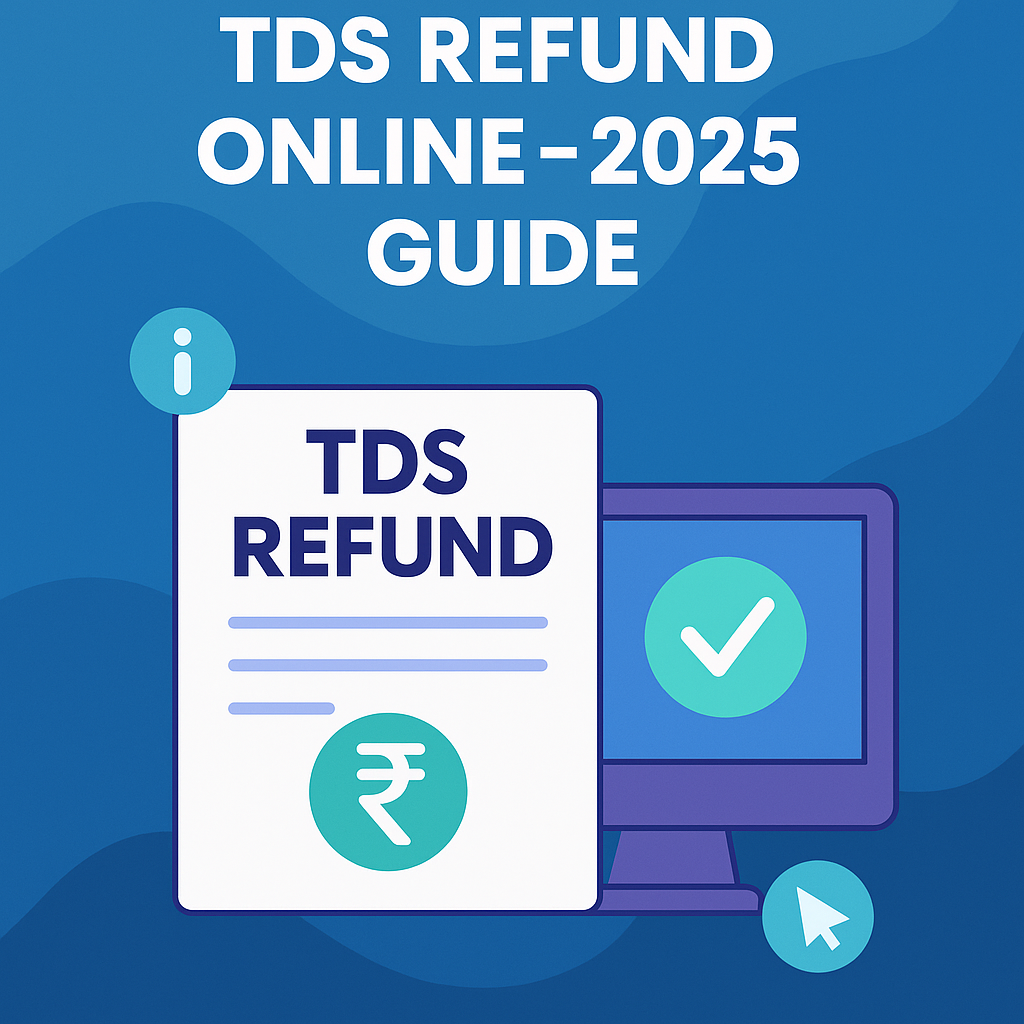🟦 Part 1: Introduction – Why You Might Be Owed a Refund
Have you ever checked your Form 26AS and realized the government deducted more tax than necessary?
That’s TDS – Tax Deducted at Source. It’s collected by employers, banks, and service clients even before you receive your income. But here’s the catch — if your total tax liability for the year is less than the TDS already deducted, you’re eligible for a TDS refund.
In 2025, millions of salaried individuals, freelancers, and even senior citizens are due TDS refunds, but many don’t know how to claim it, or worse — never check.
If you:
- Changed jobs and had excess tax deducted,
- Earned below the taxable limit but still had TDS cut from FDs,
- Work as a freelancer or contractor with TDS deducted on payouts…
…you’re probably leaving money on the table.
In this guide, we’ll walk you through how to file a TDS refund online step-by-step, avoid common mistakes, and track your refund status — all without hiring a tax expert.
🟦 Part 2: Who Can Claim a TDS Refund?
If tax has been deducted at source but your actual income tax liability is lower — or nil — you are eligible for a TDS refund. Here’s a list of people who commonly qualify:
🔹 Salaried Employees
If your employer deducted more tax than necessary (especially after a job switch or if you didn’t submit proof of investments in time), you can claim the excess back via your ITR.
🔹 Freelancers & Consultants
Many clients deduct TDS at a flat 10% under Section 194J, regardless of your actual income or deductions. If your total taxable income is lower, you’re eligible for a refund.
🔹 Fixed Deposit Holders
Banks deduct TDS at 10% on FD interest above ₹40,000 (₹50,000 for senior citizens). If your total income is below the taxable limit or eligible for deductions, you can claim it back.
🔹 Senior Citizens and Pensioners
Often fall below the taxable slab but still face TDS on interest or pension disbursal. They can claim it back if the total tax liability is lower.
🔹 NRIs (Non-Resident Indians)
TDS is deducted at higher flat rates on certain incomes. NRIs with refund eligibility can file ITR and claim excess TDS.
💡 Pro Tip: Even if your income is below the taxable limit, you must file an ITR to claim your refund.
🟦 Part 3: Documents Required Before Filing
Before you sit down to file your TDS refund, make sure you have these essentials ready. Missing even one can delay your refund or lead to incorrect filings.
✅ 1. PAN Card
Mandatory for filing ITR and matching your tax credits via Form 26AS.
✅ 2. Form 16 / Form 16A
- Form 16 is issued by employers — shows salary, deductions, and TDS.
- Form 16A is issued by banks/clients for TDS on interest or services.
✅ 3. Form 26AS
This is your tax credit statement from the Income Tax Department. It shows all TDS entries made against your PAN. Cross-verify this with Form 16/16A.
✅ 4. Annual Income Statement
You’ll need a summary of your total income from all sources — salary, interest, freelance work, rental income, etc.
✅ 5. Investment & Deduction Proofs
To claim deductions under:
- Section 80C (LIC, PPF, tuition fees, etc.)
- Section 80D (Health insurance)
- Section 24(b) (Home loan interest)
✅ 6. Bank Account Details
- Account must be pre-validated and linked to your PAN.
- Also make sure it is enabled for ECS (Electronic Clearing System) to receive the refund.
✅ 7. Aadhaar Card
Required for identity verification and e-verification of your return.
🟢 Pro Tip: Use the Income Tax Portal’s “AIS” (Annual Information Statement) to see a full picture of income and taxes deducted — a powerful tool for cross-verification.
🟦 Part 4: Step-by-Step Process to File TDS Refund Online in 2025
Filing for a TDS refund is just like filing your Income Tax Return (ITR). If your total tax liability is less than the TDS already deducted, the excess becomes refundable.
Follow this step-by-step guide:
✅ Step 1: Visit the Income Tax Portal
Go to www.incometax.gov.in and register/login using your PAN number.
✅ Step 2: Choose the Correct ITR Form
Select the applicable ITR:
- ITR-1 (Sahaj) for salaried individuals with income up to ₹50L
- ITR-2 for those with capital gains or foreign income
- ITR-3 / ITR-4 for professionals, freelancers, business owners
Use the “File Now” option under ‘e-File > Income Tax Return’.
✅ Step 3: Fill in Income Details
Manually or prefill income from:
- Salary
- Interest (FD, savings)
- Freelancing/business
- Rental income (if any)
✅ Step 4: Claim Deductions
Enter eligible deductions under:
- 80C, 80D, 80G, etc.
- Housing loan interest (Sec 24b)
- NPS contributions (80CCD)
✅ Step 5: Review TDS Details via Form 26AS
Auto-populated fields will show TDS already deducted by employer, banks, clients. Match this with your own records.
✅ Step 6: Calculate Final Tax and Refund
Portal will show:
- Total tax payable
- Total TDS already deducted
- Refund amount (if any)
✅ Step 7: E-Verify Your Return
Choose one of the e-verification methods:
- Aadhaar OTP
- Net Banking
- Demat account
- Bank account validation
✅ Step 8: Submit the Return
After verification, submit your return. Keep the acknowledgment (ITR-V) for your records.
🟢 Once processed, your refund is issued directly to your bank account via ECS.
🟦 Part 5: How to Track Your TDS Refund Status Online
Once you’ve filed your Income Tax Return and e-verified it, your TDS refund doesn’t show up instantly. It goes through processing by the Centralized Processing Centre (CPC) and then moves to refund disbursal.
Here’s how you can track it step-by-step:
🔍 Option 1: Through Income Tax Portal
- Log in to incometax.gov.in
- Navigate to ‘e-File’ > ‘Income Tax Returns’ > ‘View Filed Returns’
- Click on the relevant Assessment Year
- Check the Status Column:
- “Successfully e-verified” – Still under processing
- “Processed with refund” – Refund has been approved
- “Refund Issued” – Disbursed to bank
🔍 Option 2: Through TIN NSDL Refund Status Portal
- Visit tin.tin.nsdl.com/oltas/refund-status
- Enter your PAN and Assessment Year
- A message will display the current refund status, such as:
- “Refund credited”
- “Refund sent to bank”
- “Refund failed – invalid account”
- “Refund returned – contact CPC”
🟢 Common Refund Status Messages
| Status | What It Means |
|---|---|
| Refund Successfully Credited | Amount received in your bank |
| Refund Failed | Invalid bank details – revalidate |
| Refund Returned | Bank account issues – contact CPC |
| Refund Under Processing | No action needed – wait |
🧾 Bonus Tip: Enable Email/SMS Alerts
Refund updates are also sent to your registered email ID and mobile number linked to your IT portal account.
🟦 Part 6: Common Mistakes to Avoid While Claiming TDS Refund
Claiming your TDS refund may seem straightforward, but small errors can delay or even invalidate your refund. Avoid these common mistakes:
❌ 1. Not Matching Form 26AS and AIS
- Many taxpayers skip verifying their TDS entries in Form 26AS or ignore mismatches in the Annual Information Statement (AIS).
- Mismatch = delayed processing or incorrect refund.
🟢 Always verify that TDS details match what’s filed in your return.
❌ 2. Wrong Bank Account for Refund
- If your refund is sent to a non-validated or inactive bank account, it will fail.
- Refunds only go to pre-validated accounts linked to PAN.
🟢 Revalidate your bank account under ‘Profile > My Bank Account’ on the portal.
❌ 3. Forgetting to E-Verify the Return
- Filing the return without e-verifying = your return is not considered valid.
🟢 Always complete e-verification immediately after filing.
❌ 4. Incorrect ITR Form
- Using ITR-1 when you actually need ITR-2/3 (for multiple income sources or capital gains) may trigger notices.
🟢 Use the ITR selection tool on the portal if unsure.
❌ 5. Missing Deduction Claims
- People forget to include eligible deductions (e.g., 80D for health insurance, 80G for donations).
🟢 Use last year’s return as a checklist to ensure all deductions are captured.
❌ 6. Filing After the Deadline
- If you miss the due date (typically 31st July for individuals), you lose out on interest on refund and face penalties.
🟦 Part 7: TDS Refund Timeframes, Interest & Taxability in 2025
Claimed your TDS refund? Let’s understand how long it takes, whether you earn interest, and if that interest is taxable.
⏳ TDS Refund Timeframe
- ✅ Returns filed before July 31st: Refunds are typically processed within 20 to 45 days.
- ✅ Returns filed after the due date: May take longer — up to 3-6 months, especially during peak tax season.
📌 Use the tracking options (IT portal or NSDL) covered in Part 5.
💸 Interest on TDS Refund
- Under Section 244A of the Income Tax Act:
- If refund is delayed by more than 3 months, you earn simple interest @ 0.5% per month (6% per annum).
- Interest is automatically calculated and added to the refund by the CPC.
🟢 Example:
Refund of ₹10,000 delayed by 6 months = ₹300 interest.
🧾 Is TDS Refund Interest Taxable?
- Yes, the interest received on your refund is treated as “Income from Other Sources.”
- It must be declared in your ITR for the year in which it is received.
⚠️ Many taxpayers miss this and receive IT notices later.
💡 Pro Tip: Even ₹100 interest should be declared to avoid mismatch with AIS/Form 26AS.
🟦 Part 8: Conclusion – Don’t Leave Your Money on the Table
A TDS refund is not a bonus—it’s your hard-earned money that’s been over-deducted. Most salaried employees, freelancers, senior citizens, and even small investors often miss out on claiming their rightful refund due to lack of awareness or common filing mistakes.
By understanding your eligibility, verifying Form 26AS, and filing your ITR properly, you can ensure timely refund—along with any applicable interest.
🔗 Recommended Reading:
To complete your understanding of related financial essentials, check out:
- ✅ How to Check EPF Balance Online – 2025 Guide
- ✅ How to Link PAN with Aadhaar Online – 2025
- ✅ PAN Card Correction Online – Mistake Fix Kaise Karein (2025 Guide)
- ✅ Download PAN Card Online – 2025 Guide
🌐 Stay updated with more simplified, Hindi-English blended guides at SmartIndiaHelp.com — your digital shortcut to government services.

